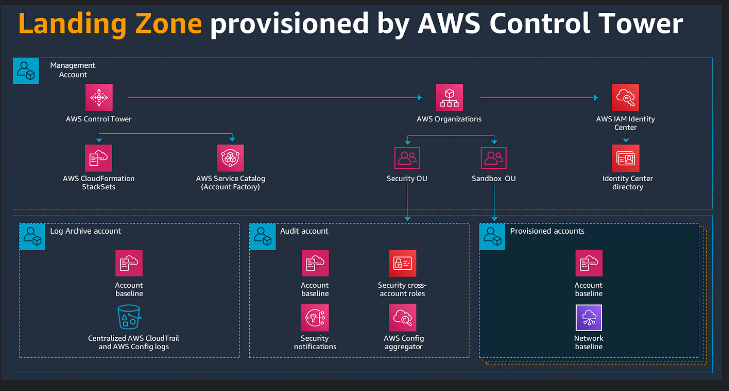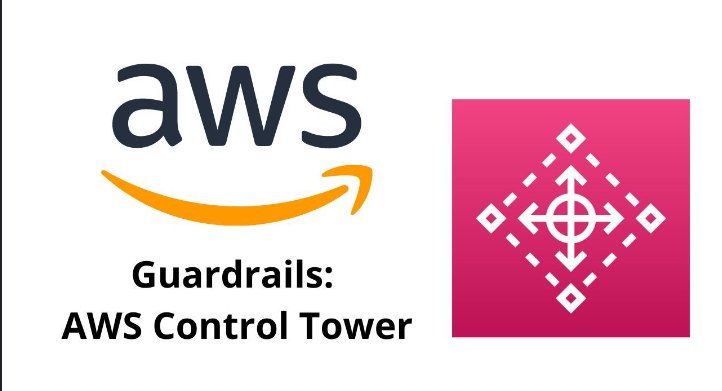Understanding AWS Control Tower: Your Guide to Secure Multi-Account Management

In today's fast-paced digital landscape, managing multiple AWS accounts can be a complex and challenging endeavor. With the growing need for security, efficiency, and compliance in cloud deployments, AWS Control Tower emerges as a comprehensive solution. This guide looks at the intricacies of AWS Control Tower, offering you a detailed, clear, and optimized approach to understanding and leveraging its capabilities for your cloud infrastructure.
Introduction to AWS Control Tower
AWS Control Tower is designed to simplify and streamline the management of multi-account AWS environments by providing a set of automated tools and best practices. It ensures security, compliance, and governance across all accounts within an organization. Here’s a detailed look at how AWS Control Tower works, covering its key components, setup process, and the ongoing management of AWS environments.
Key Components of AWS Control Tower
Landing Zone: The foundational framework that Control Tower sets up in your AWS environment. It includes:
Organizational Units (OUs): Logical groupings of AWS accounts within AWS Organizations, allowing for hierarchical management and policy application.
Guardrails: Pre-configured rules that enforce security and compliance. These include Service Control Policies (SCPs) and AWS Config rules.
Account Factory: A provisioning tool that automates the creation of new AWS accounts within the landing zone, ensuring they adhere to predefined configurations and security settings.
Guardrails: These are automated policies that ensure security and compliance. They are categorized into:
Mandatory Guardrails: Enforced by default to maintain baseline security and compliance.
Optional Guardrails: Can be enabled or customized to meet specific organizational needs.
AWS Organizations: A service that provides the core framework for managing multiple AWS accounts. It offers features like consolidated billing, centralized management of policies, and account organization through OUs.
Let us now explore each of these concepts in more detail.
The Power of Automation: Building a Secure Landing Zone
What is a Landing Zone?

A landing zone is a pre-configured environment that sets up the necessary infrastructure to manage multiple AWS accounts securely. Control Tower automates the creation of this landing zone, adhering to security best practices and organizational requirements. Key components of a landing zone include:
1. Organizational Units (OUs) within AWS Organizations: These logical groupings allow for hierarchical organization of your accounts, making it easier to manage and apply policies.
2. Pre-defined Security Policies: Utilizing AWS Config rules and Service Control Policies (SCPs), Control Tower enforces security best practices from the start, ensuring a consistent security posture.
3. Streamlined Account Provisioning: Control Tower automates the provisioning of new accounts within your landing zone, applying security configurations automatically to save time and maintain consistency.
Setting Up Your Landing Zone
Setting up a landing zone with AWS Control Tower involves several steps:
1. Sign In to the AWS Management Console: Begin by signing into your AWS Management Console with the necessary administrative privileges.
2. Launch AWS Control Tower: Navigate to the AWS Control Tower service and initiate the setup process.
3. Configure Organizational Units: Define your organizational units (OUs) to categorize your accounts based on business functions or compliance needs.
4. Apply Pre-defined Security Policies: Choose from a range of AWS Config rules and SCPs to enforce security policies across your accounts.
5. Automate Account Provisioning: Use the Control Tower interface to provision new accounts, ensuring they automatically adhere to your security and compliance standards.
By automating these steps, Control Tower reduces the risk of human error and ensures a secure, compliant foundation for your cloud environment.
Guardrails for Governance: Enforcing Security and Compliance
Understanding Guardrails

Guardrails in AWS Control Tower are pre-configured rules that enforce best practices and compliance standards. They consist of:
- Service Control Policies (SCPs): These policies restrict access to specific AWS services and actions, ensuring that accounts comply with your organization's security requirements.
- AWS Config Rules: These rules evaluate the configurations of your AWS resources to ensure they comply with predefined standards.
- Service Catalog Constraints: These constraints control how AWS Service Catalog products can be deployed, ensuring they meet your governance requirements.
Types of Guardrails
AWS Control Tower provides two types of guardrails:
1. Mandatory Guardrails: These are enforced by default and cannot be modified. They ensure fundamental security and compliance across all accounts.
2. Optional Guardrails: These can be enabled or customized based on your organization's specific needs. They offer additional layers of security and compliance tailored to your environment.
Customizing Guardrails
While Control Tower offers a robust set of pre-built guardrails, customization is key to meeting your unique requirements. You can tailor these guardrails to:
- Align with industry-specific regulations (e.g., HIPAA, GDPR)
- Meet internal security standards
- Address specific operational needs
By customizing guardrails, you ensure that your AWS environment is both secure and compliant with your organizational policies.
Beyond Automation: Advanced Control Tower Features
Third-Party Integration
AWS Control Tower seamlessly integrates with various third-party security and compliance tools. This integration allows you to extend your existing security framework and gain a comprehensive view of your cloud security posture. Examples of third-party tools include:
- Security Information and Event Management (SIEM) Solutions: Integrate with tools like Splunk or IBM QRadar to monitor and analyze security events.
- Compliance Management Tools: Use solutions like CloudHealth or Dome9 to ensure ongoing compliance with industry standards.
Cost Optimization
Control Tower also aids in cost optimization by:
- Enforcing Resource Tagging: Ensure that all resources are tagged appropriately, enabling better cost tracking and allocation.
- Limiting Service Usage: Use SCPs to restrict access to high-cost services, preventing unauthorized or unnecessary usage.
By leveraging these features, you can achieve better resource management and cost visibility within your multi-account environment.
Understanding the AWS Organizations Connection
AWS Organizations is the backbone of AWS Control Tower, providing essential functionalities for account management. Key features include:
- Consolidated Billing: Aggregate billing for all your accounts, simplifying financial management and offering potential cost savings through volume discounts.
- Centralized IAM Controls: Manage IAM policies centrally, ensuring consistent access controls across all accounts.
Control Tower builds upon this foundation, adding a layer of automation and pre-configured security best practices to streamline multi-account management.
Practical Scenarios: Implementing AWS Control Tower
Scenario 1: Large Enterprise Deployment - Compartmentalized Security and Scalable Growth
Challenge: A multinational corporation with diverse departments like finance, marketing, and IT needs to manage a sprawling AWS environment. They require compartmentalized security, adherence to global and local compliance mandates, and efficient account provisioning.
Control Tower Solution:
- Departmental OUs: Create Organizational Units (OUs) within AWS Organizations for each department. This facilitates centralized management while isolating resources and access controls for each department.
- Tailored Guardrails: Define custom guardrails with SCPs and Config rules for each OU. These guardrails can enforce department-specific security policies and compliance requirements (e.g., restricting access to certain services for finance).
- Account Factory: Leverage Account Factory for automated account provisioning. This ensures new accounts are created within the designated OU and automatically inherit the relevant guardrails, streamlining account setup and reducing human error.
Scenario 2: Startups and Small Businesses - Fast, Secure Cloud Adoption
Challenge: Startups and small businesses often lack extensive cloud expertise. Setting up a secure and compliant AWS environment can be daunting. These organizations require a quick and easy solution to establish a secure foundation for their cloud journey.
Control Tower Solution:
- Pre-configured Guardrails: Control Tower's pre-defined guardrails provide a solid security posture right from the start. These best-practice guardrails help startups meet industry standards and mitigate potential security risks without extensive manual configuration.
- Reduced Overhead: By automating security configuration and compliance enforcement, Control Tower frees up valuable time and resources for startups to focus on core business activities like innovation and growth. The intuitive interface simplifies cloud management and reduces the need for specialized cloud expertise.
Scenario 3: Regulated Industries - Stringent Compliance Made Easy
Challenge: Highly regulated industries (healthcare, finance) face strict compliance requirements like HIPAA and GDPR. They need their AWS environments to be demonstrably compliant and require robust controls to ensure continuous adherence.
Control Tower Solution:
- Customizable Guardrails: Control Tower empowers organizations to tailor guardrails to meet specific regulatory requirements. This allows them to enforce strict access controls, data encryption standards, and other industry-specific security measures.
- Automated Compliance Monitoring: Control Tower automates compliance monitoring through AWS Config rules. This provides continuous visibility into the compliance posture of your environment. Additionally, automated remediation capabilities can address any configuration drift that might lead to non-compliance.
How to get started with AWS Control Tower
To get started with AWS Control Tower, you follow these steps:
Sign In to the AWS Management Console: Use an AWS account with administrative privileges to access the console.
Launch AWS Control Tower: Navigate to the Control Tower service and initiate the setup process.
Configure Organizational Units (OUs): Define the structure of your organization by creating OUs to group your accounts based on business functions, compliance needs, or other criteria.
Set Up Guardrails: Select and apply a combination of mandatory and optional guardrails to enforce security and compliance across your accounts.
Provision Accounts with Account Factory: Use the Account Factory to automate the creation and configuration of new AWS accounts, ensuring they adhere to your landing zone’s security and governance policies.
Benefits of Using AWS Control Tower
Simplified Multi-Account Management: Centralized management of multiple AWS accounts through a single interface.
Automated Security and Compliance: Pre-configured guardrails enforce security best practices and compliance standards automatically.
Efficient Account Provisioning: The Account Factory automates the creation of new accounts, ensuring consistent configurations and security policies.
Cost Management: By enforcing resource tagging and usage limits, Control Tower helps in managing and optimizing costs.
Scalability: Easily scale your AWS environment by adding new accounts and resources without compromising on security or compliance.
Final Thoughts on Control Tower
AWS Control Tower is a powerful tool that simplifies the setup and governance of secure multi-account AWS environments. By automating the creation of a secure landing zone, enforcing security policies through guardrails, and offering customization options, it empowers you to manage your cloud infrastructure efficiently and securely. Understanding Control Tower's technical capabilities allows you to unlock its full potential, building robust and secure multi-account architectures in the AWS cloud.
Happy Clouding !!!
Did you like this post?
If you did, please buy me coffee 😊
No comments yet.